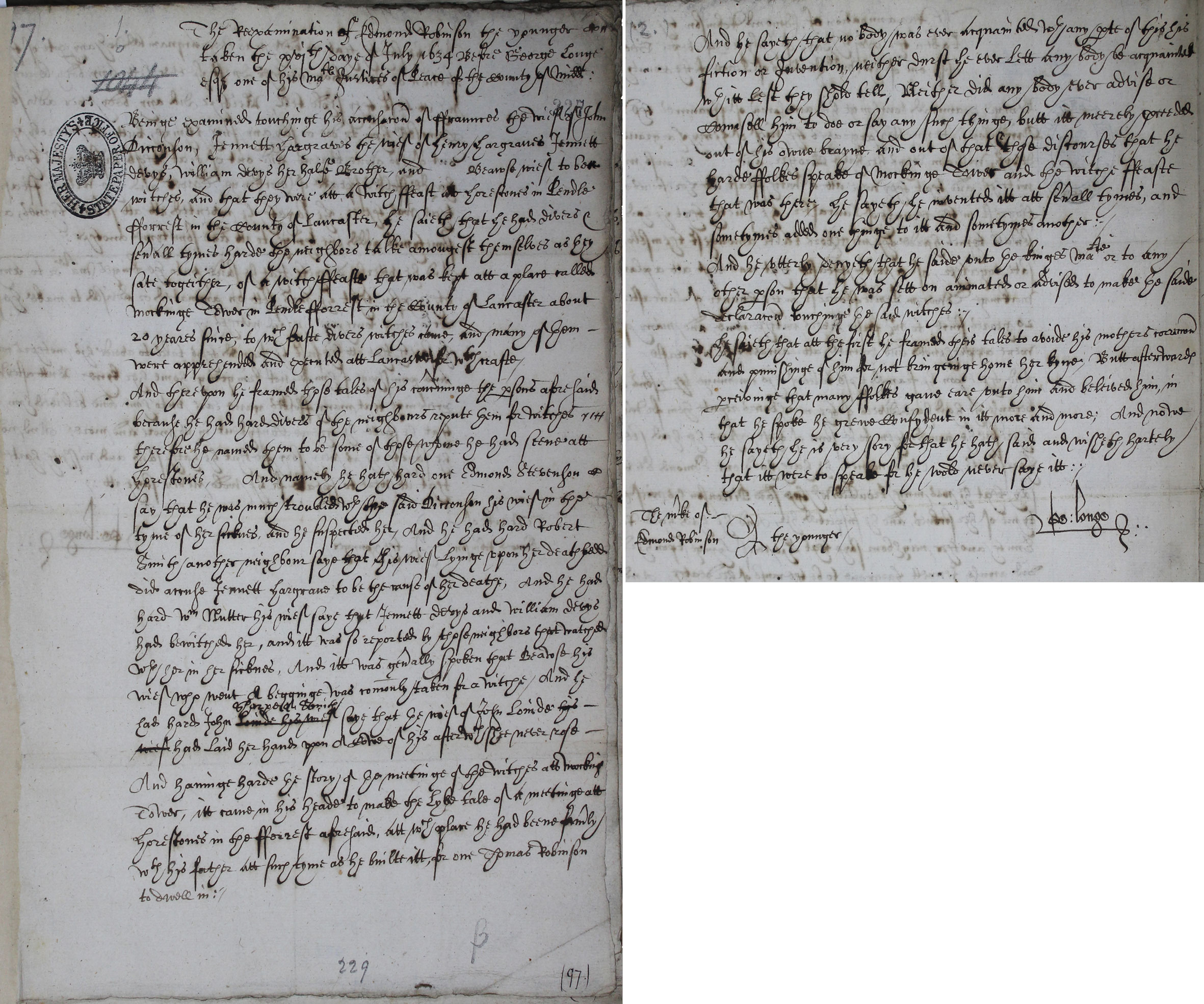
The Lancaster Witches: re-examination of Edmund Robinson the younger. (Catalogue ref: SP 16/271 f.227)
During the course of the trial of the Lancaster Witches one of the key witnesses, a young boy named Edmund Robinson, gave new evidence in which he admitted that he fabricated the accusations against the witches,16 July, 1634.
Transcript
Page One: (a)
- The re-examination of Edmund Robinson the younger,
- taken the xvj [16] day of July 1634 before George Long
- esquire one of his majesty’s Justices of Peace of the county of Middlesex.
- Being examined touching his accusation of Frances, the wife of John
- Dickenson, Jennet Hargraves the wife of Henry Hargraves, Jennet
- Devys, William Devys, her half brother, and Beawser to be
- witches, and that they were at a witch feast at Horestones in Pendle
- Forest in the County of Lancaster, he says that he had had divers [many] &
- several times heard the neighbours talk amongst themselves as they
- sat together, of a witch feast that was kept at a place called
- Mocking Tower in Pendle Forest in the County of Lancaster about
- 20 years since, to which feast divers witches came, and many of them
- were apprehended and executed at Lancaster for witchcraft.
- And thereupon he framed those tales of his concerning the persons aforesaid,
- because he had heard divers of the neighbours repute them for witches.
- Therefore he named them to be some of those whom he had seen at
- And namely he hath heard one Edmund Stevenson
- say that he was much troubled with the said Dickenson his wife in the
- time of his sickness, and that he suspected her, and he heard Robert
- Smith, another neighbour, say that his wife, lying upon her death bed
- did accuse Jennet Hargraves to be the cause of her death. And he
- had heard William Nutter his wife say that Jennet Devys and William Devys
- had bewitched her; and it was so reported by those neighbours that watched
- with her in her sickness. And it was generally spoken that Beawse his
- wife, who went a-begging, was commonly taken for a witch, and he
- had heard Sharpee Smith say that the wife of John Loynd
- had laid her hand upon a cow of his, after which she never rose.
- And having heard the story of the meeting of the witches at Mocking
- Tower, it came in his head to make the like tale of a meeting at
- Horestones in the forest aforesaid, at which place he had been formerly
- with his father at such time as he built it for Thomas Robinson to dwell in.
Page Two: (b)
- And he sayeth that nobody was ever acquainted with any part of this his
- fiction or intention, neither durst [did] he ever let anybody be acquainted
- with it less they should tell. Neither did anybody ever advise or
- counsel him to do or say anything, but it merely proceeded
- out of his own brain and out of that those discourses that he
- heard folk speak of Mocking Tower and the Witch Feast
- that was there. He says he invented it at several times and
- sometimes added one thing to it all and sometimes another.
- And he utterly denies that he said unto the Kings Majesty or to any
- other person that he was set on animated or advised to make the said
- declarations touching the said witches.
- He says that at the first he framed these tales to avoid his mother’s correction
- and punishing of him for not bringing home her [kin?]. But afterwards
- perceiving that many folks gave care unto him and believed him, in
- that he spoke he grew confident in it more and more. And now
- he sayeth he is very sorry for that he hath said and wishes heartily
- that it were to speak for he would never say it.
- The mark of
- Edmond Robinson the Younger
